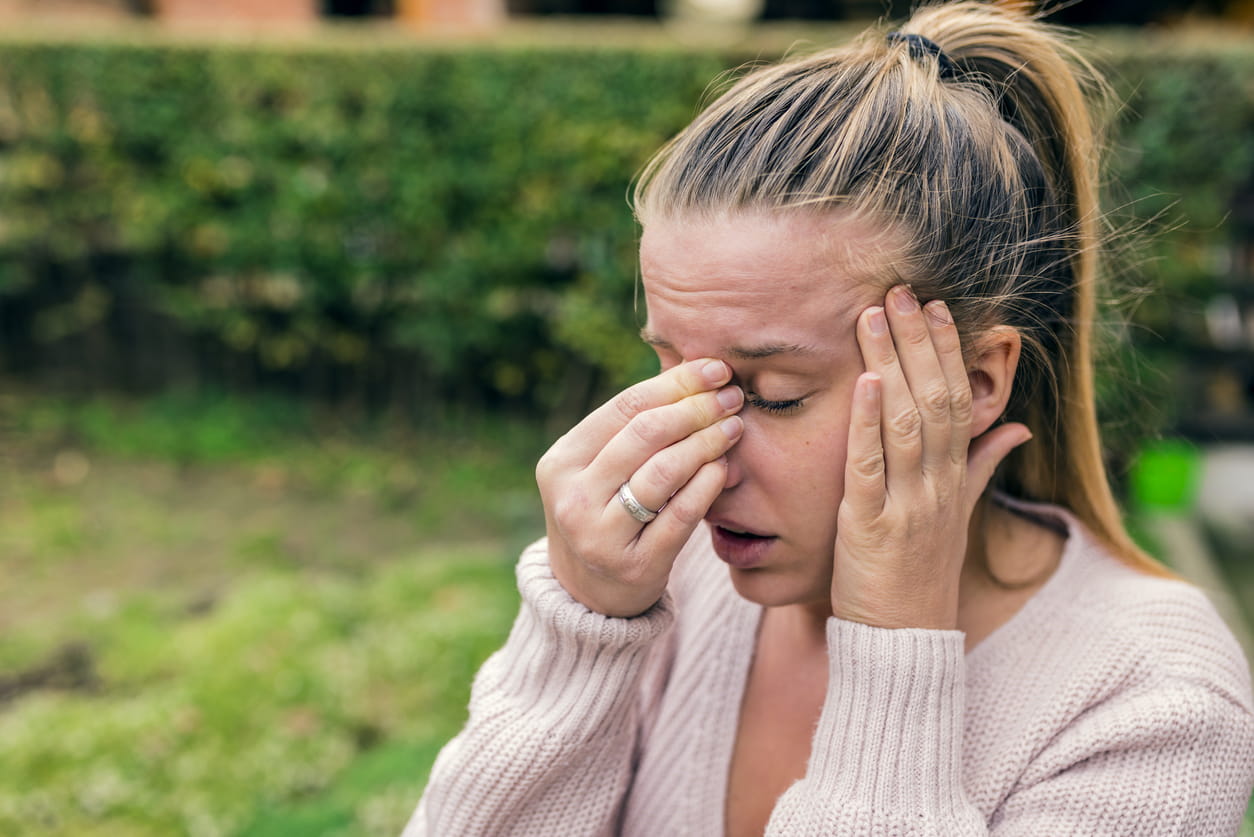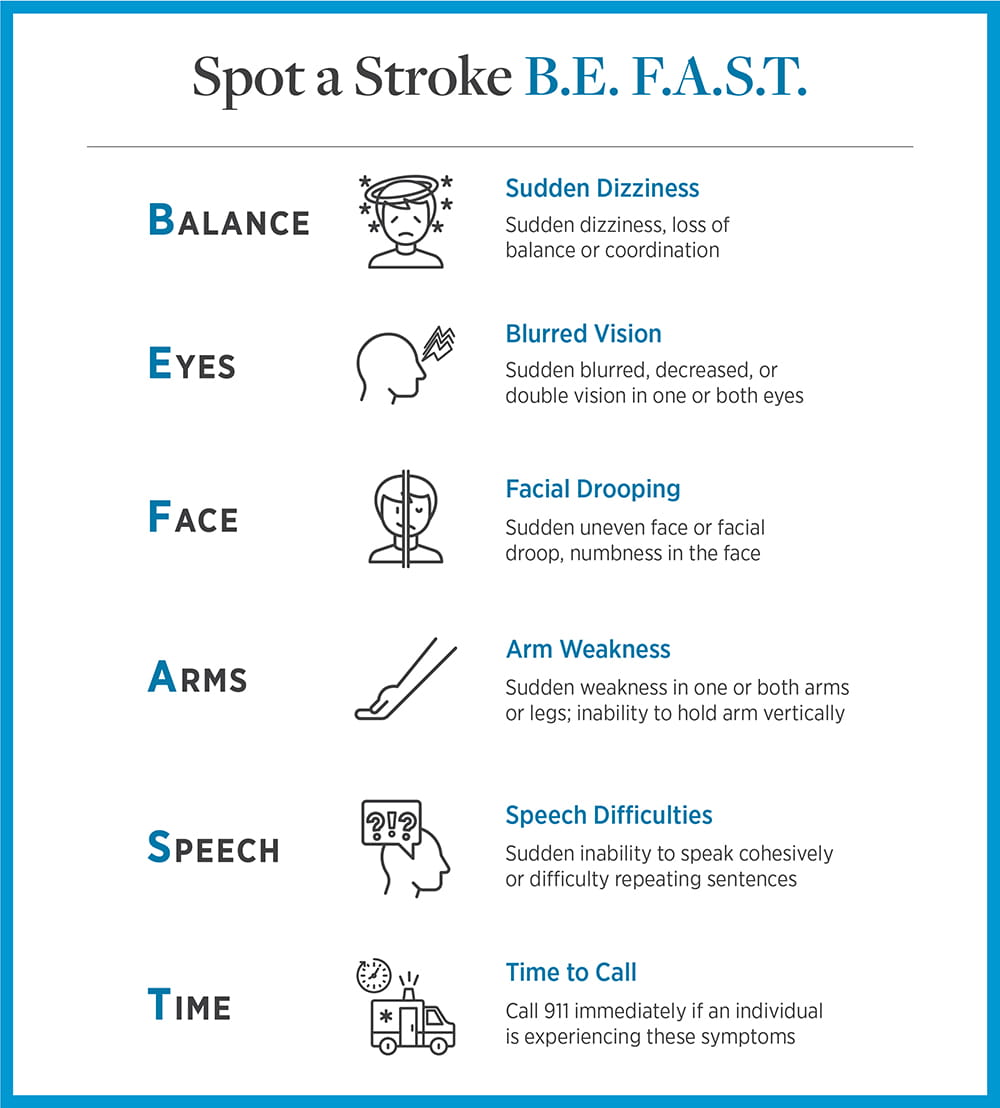Stroke can occur at any age: How to recognize stroke symptoms

Chances are you've heard the phrase before: Time is brain — referring to the importance of timely care in the event of a stroke to preserve brain function. But do you know how to recognize stroke symptoms in yourself or a loved one?
"Most people know how dangerous and debilitating a stroke can be, but not as many people would be able to quickly identify it if it was happening to them or someone around them," says Michelle J. Smith, MD, chief of neurosurgery at Main Line Health-Jefferson Neurosurgery. "Familiarizing yourself with the symptoms of a stroke can help save a life."
Here's how to recognize stroke symptoms:
Headache
Headaches that accompany a stroke are often described as "thunderclap" headaches because they are sudden and severe. In some cases, they can also be accompanied by a brief lack of consciousness.
Changes in vision
A number of vision changes can signal a stroke, including difficulty seeing in one or both of your eyes, a brief loss of vision, blurry or darkened vision or seeing double. These changes are caused by blocked blood vessels in the retina or brain.
Trouble speaking
"One of the hallmark signs of a stroke is difficulty speaking, like slurring your words, inability to get words out or having trouble understanding someone else when they speak," says Dr. Smith. If you suspect someone is having a stroke, ask them to repeat a basic phrase to determine whether or not their speech is affected.
Lack of coordination
Everyone can trip over their own feet sometimes, but a stroke causes a unique lack of coordination. Strokes can cause dizziness and vertigo, a loss of balance or stumbling, even if you're walking slowly and deliberately.
Weakness/numbness
People who have suffered a stroke often describe the feeling of weakness or numbness in their arms, legs or face. This sensation can occur on one or both sides of the body, and there's an easy way to test for it.
"Raise both of your hands in front of your chest at the same time. If you can only hold up one arm and are having difficulty lifting the other or if it starts to fall, you might be having a stroke. You can also try smiling. If one side of your face droops while the other lifts, this can also be a sign of a stroke," says Smith.
All four Main Line Health hospitals are certified primary stroke centers and have received Gold-level performance in the Get with the Guidelines®- Stroke program from the American Heart Association.
Remembering symptoms — B.E.F.A.S.T.
Fortunately, there's an easy trick to help you remember how to recognize stroke symptoms and B.E.F.A.S.T.
Explains Smith. "It's a very simple way to remember how to recognize symptoms of stroke and a reminder of how important it is to act quickly."

If you're experiencing one or more of these symptoms, call 911 for immediate medical attention.
Timely stroke treatment options
Approximately 795,000 Americans die every year as a result of stroke. The majority of these are ischemic strokes, which are caused by a blood clot blocking blood flow to the brain. Timely treatment has the ability to help save lives and preserve brain function.
Traditionally, there are two treatment options for acute ischemic strokes:
- tPA: An intravenous drug called alteplase, or tPA, delivered through an IV in the arm, tPA works to dissolve blood clots and improve blood flow. Unfortunately, the drug's effectiveness also relies on size of the blood clot and the immediate recognition of a stroke.
"tPA is considered a first line of defense against stroke, but in order for it to be effective the clot cannot be too large and it has to be administered within three to 4.5 hours," explains Smith. "For patients who don't recognize stroke symptoms right away or whose blood clot is too large, tPA alone is unlikely to help treat their stroke."
- Thrombectomy: A minimally invasive, endovascular procedure offered at Bryn Mawr Hospital, part of Main Line Health, during which physicians thread a catheter through a vessel in the groin up to a blocked vessel in the patient's brain to clear it. Until recently, thrombectomy was only considered effective until up to six hours after the onset of stroke symptoms. After new research and guidelines from the American Stroke Association, however, certain patients are now eligible to undergo thrombectomy up to 24 hours after their symptoms begin.
"There are many reasons why people may not get timely stroke treatment — some patients suffer a stroke in their sleep, while others may not recognize the symptoms," says Smith. "This increased treatment time allows us to save lives and improve the quality of many more."
Bryn Mawr Hospital is a Thrombectomy-Capable Stroke Center (TSC) certified by The Joint Commission, in collaboration with the American Heart Association/American Stroke Association (AHA/ASA). This certification signifies the hospital meets rigorous standards for performing mechanical endovascular thrombectomy, a specialized surgical procedure used to remove a blood clot from the brain during an ischemic stroke.
Although the revised thrombectomy guidelines have improved treatment options for patients across the country, it doesn't mean you should delay if you notice yourself or someone else having stroke symptoms.
"It's still critical to seek medical attention as soon as you notice stroke symptoms. Remember, time is brain," says Smith.
If you're experiencing one or more of these symptoms, 'Don't Die of Doubt,' says the American Heart Association. Call 911 for immediate medical attention.
While thrombectomy is beginning to transform stroke care, the treatment isn't available in many regions. Bryn Mawr Hospital and Dr. Smith are proud to be able to offer mechanical thrombectomy as a stroke treatment option for our community.
Next steps:
Make an appointment with Michelle J. Smith, MD
Learn more about about stroke care at Main Line Health
The basics of stroke and stroke-related aphasia
 Content you want, delivered to your inbox
Content you want, delivered to your inbox
Want to get the latest health and wellness articles delivered right to your inbox?
Subscribe to the Well Ahead Newsletter.
